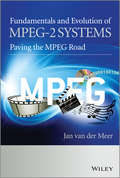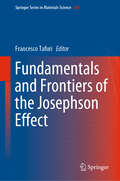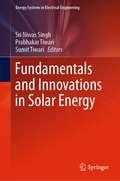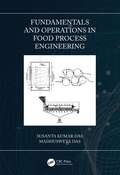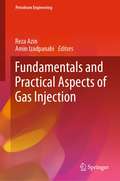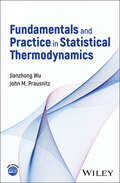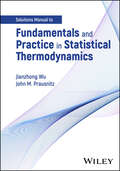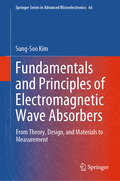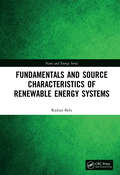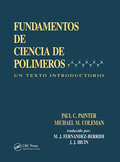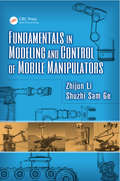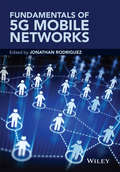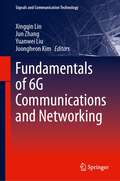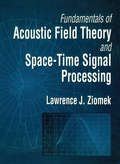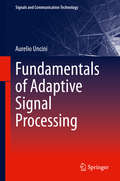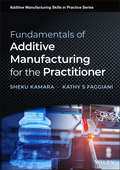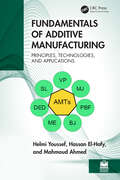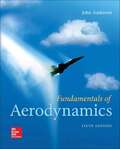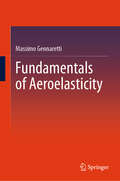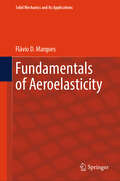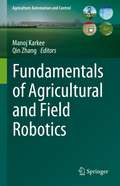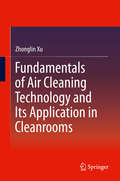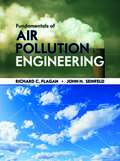- Table View
- List View
Fundamentals and Evolution of MPEG-2 Systems
by Jan Van der MeerThis book describes the fundamentals and details of MPEG-2 Systems technologyWritten by an expert in the field, this book examines the MPEG-2 system specification as developed in the early 1990's, as well as its evolution into the fourth edition of the MPEG-2 systems standard, published in 2013. While MPEG-2 systems will continue to evolve further, this book describes the MPEG-2 system functionality as of October 2013. Furthermore, relevant background information is provided. The discussion of MPEG-2 system functionality requires knowledge of various fundamental issues, such as timing, and supported content formats. Therefore also some basic information on video and audio coding is provided, including their evolution. Also other content formats supported in MPEG-2 systems are described, as far as needed to understand MPEG-2 systems.Ordered logically working from the basics and background through to the details and fundamentals of MPEG-2 transport streams and program streamsExplores important issues within the standardization process itselfPuts the developments on MPEG-2 systems into historic perspectiveIncludes support of 3D Video and transport of AVC, SVC and MVCConcludes with additional issues such as real-time interface, delivery over IP networks and usage by application standardization bodiesPredicts a continuing promising future for MPEG-2 transport streams
Fundamentals and Frontiers of the Josephson Effect (Springer Series in Materials Science #286)
by Francesco TafuriThis book provides a comprehensive and up-to-date description of the Josephson effect, a topic of never-ending interest in both fundamental and applied physics. In this volume, world-renowned experts present the unique aspects of the physics of the Josephson effect, resulting from the use of new materials, of hybrid architectures and from the possibility of realizing nanoscale junctions. These new experimental capabilities lead to systems where novel coherent phenomena and transport processes emerge. All this is of great relevance and impact, especially when combined with the didactic approach of the book. The reader will benefit from a general and modern view of coherent phenomena in weakly-coupled superconductors on a macroscopic scale. Topics that have been only recently discussed in specialized papers and in short reviews are described here for the first time and organized in a general framework. An important section of the book is also devoted to applications, with focus on long-term, future applications. In addition to a significant number of illustrations, the book includes numerous tables for comparative studies on technical aspects.
Fundamentals and Innovations in Solar Energy (Energy Systems in Electrical Engineering)
by Sri Niwas Singh Prabhakar Tiwari Sumit TiwariThis book provides recent trends and innovation in solar energy. It covers the basic principles and applications of solar energy systems. Various topics covered in this book include introduction and overview of solar energy, solar PV generation, solar thermal generation, innovative applications of solar energy, smart energy system, smart grid and sustainability, solar energy forecasting, advances in solar battery, thermal storage of solar energy, solar energy pricing, advances in hybrid solar system, solar system tracking for maximum power generation, phase change materials and its application, sensitivity analysis in solar systems, environmental feasibility of solar hybrid systems, regulatory implications of solar energy integration with grid, impact of the photovoltaic integration on the hydrothermal dispatch on power systems and potential and financial evaluation of floating solar PV in Thailand—a case study. This book will be useful for the students, academicians, researchers, policymakers, economists and professionals working in the area of solar energy.
Fundamentals and Operations in Food Process Engineering
by Susanta Kumar Das Madhusweta DasFundamentals and Operations in Food Process Engineering deals with the basic engineering principles and transport processes applied to food processing, followed by specific unit operations with a large number of worked-out examples and problems for practice in each chapter. The book is divided into four sections: fundamentals in food process engineering, mechanical operations in food processing, thermal operations in food processing and mass transfer operations in food processing. The book is designed for students pursuing courses on food science and food technology, including a broader section of scientific personnel in the food processing and related industries.
Fundamentals and Practical Aspects of Gas Injection (Petroleum Engineering)
by Reza Azin Amin IzadpanahiThis book covers different aspects of gas injection, from the classic pressure maintenance operation to enhanced oil recovery (EOR), underground gas storage (UGS), and carbon capture and storage (CCS). The authors detail the unique characteristics and specific criteria of each application, including: material balance equationsphase behaviourreservoir engineeringwell designoperating aspectssurface facilitiesenvironmental issues Examples, data, and simulation codes are provided to enable the reader to gain an in-depth understanding of these applications. Fundamentals and Practical Aspects of Gas Injection will be of use to practising engineers in the fields of reservoir engineering, and enhanced oil recovery. It will also be of interest to researchers, academics, and graduate students working in the field of petroleum engineering.
Fundamentals and Practice in Statistical Thermodynamics
by Jianzhong Wu John M. PrausnitzBridge the gap between thermodynamic theory and engineering practice with this essential textbook Thermodynamics is a discipline which straddles the fields of chemistry, physics, and engineering, and has long been a mainstay of undergraduate and graduate curricula. Conventional thermodynamics courses, however, often ignore modern developments in statistical mechanics, such as molecular simulation methods, cooperative phenomena, phase transitions, universality, as well as liquid-state and polymer theories, despite their close relevance to both fundamental research and engineering practice. Fundamentals and Practice in Statistical Thermodynamics fills this gap with an essential book that applies up-to-date statistical-mechanical techniques to address the most crucial thermodynamics problems found in chemical and materials systems. It is ideally suited to introduce a new generation of researchers and molecular engineers to modern thermodynamic topics with numerous cutting-edge applications. From Fundamentals and Practice in Statistical Thermodynamics readers will also find: An introduction to statistical-mechanical methods including molecular dynamics simulation, Monte Carlo simulation, as well as the molecular theories of phase transitions, classical fluids, electrolyte solutions, polymeric materials, and more Illustrative examples and exercise problems with solutions to facilitate student understandingSupplementary online materials covering the basics of quantum mechanics, density functional theory, variational principles of classical mechanics, intermolecular interactions, and many more subjects Fundamentals and Practice in Statistical Thermodynamics is ideal for graduate and advanced undergraduate students in chemical engineering, biomolecular engineering, environmental engineering, materials science and engineering, and all related scientific subfields of physics and chemistry.
Fundamentals and Practice in Statistical Thermodynamics, Solutions Manual
by Jianzhong Wu John M. PrausnitzThis is a solutions manual to accompany Fundamentals and Practice in Statistical Thermodynamics This textbook supplements, modernizes, and updates thermodynamics courses for both advanced undergraduates and graduate students by introducing the contemporary topics of statistical mechanics such as molecular simulation and liquid-state methods with a variety of realistic examples from the emerging areas of chemical and materials engineering. Current curriculum does not provide the necessary preparations required for a comprehensive understanding of these powerful tools for engineering applications. This text presents not only the fundamental ideas but also theoretical developments in molecular simulation and analytical methods to engineering students by illustrating why these topics are of pressing interest in modern high-tech applications.
Fundamentals and Principles of Electromagnetic Wave Absorbers: From Theory, Design, and Materials to Measurement (Springer Series in Advanced Microelectronics #66)
by Sung-Soo KimThis book consists of three main parts: fundamental theory, design principles and methodology, and potential materials that can be applied to EM wave absorbers. In the theory part, this book provides the basics of electromagnetism, circuit and transmission line theory, EM wave propagation and reflection, and complex permittivity and permeability by electric polarization and magnetization of materials. In the design part, design methods are explained for various types of EM wave absorbers based on equivalent circuit models and simulation technologies. Starting from the traditional resonance-type absorber, this book reviews the latest metamaterial and frequency selection surface (FSS) absorbers with more advanced design techniques. Recent research results are also included associated with how to design the ultrawide-bandwidth absorbers through multilayering FSSs or shape-control of lossy materials. In the materials section, various lossy materials are reviewed that can be used as EM wave absorbers, including conductive materials, magnetic materials, dielectric materials, core-shell materials, fiber-reinforced composite materials, and metamaterials or metasurfaces. Literature reviews on their electromagnetic properties and EM wave absorption performance are also presented. Finally, the methods and principles for measuring the high-frequency properties (complex permittivity and permeability) and EM wave absorption are described.
Fundamentals and Source Characteristics of Renewable Energy Systems (Nano and Energy)
by Radian BeluThis textbook is intended for an audience with little or no power engineering or renewable energy background. The book covers electric energy from alternative energy sources, including solar, wind, water, hydropower, geothermal, and ocean energy. Core issues discussed include wind and solar resource estimates and analysis, solar thermal systems, solar collectors, photovoltaics, wind turbines, geothermal energy, energy small hydropower, wave, tide and ocean energy, and characteristics of energy conversion, control, and electrical aspects. This is one of the most comprehensive textbooks for students, engineers, and professionals who study renewable energy. There are several questions and problems, presented with increasing difficulty, most of which focus on practical applications. The materials and problems are drawn from the author’s extensive experience in renewable energy analysis, assessment, design, control, and the power electronics of wind and solar energy conversion systems. Each section of the book contains several solved examples, as well as practical and advanced discussions, that instill critical thinking and apply to industrial applications. The book is divided into eight chapters and covers the most important aspects of renewable energy sources and technologies.
Fundamentals de Ciencia de Polimeros: Un Texto Introductorio
by Juan J. Iruin Maria J. Fernandez-BerridiThis is a new, basic introduction to polymer science. It is both comprehensive and readable. The authors are leading educators in this field with extensive backgrounds in industrial and academic polymer research. The text starts with a description of the types of microstructures found in polymer materials. This provides an understanding of some of the key features of the various mechanisms of homopolymerization and copolymerization which are discussed in following chapters. Also discussed in these chapters are the kinetics and statistics of polymerization, with a separate chapter on the characterization of chain structure by spectroscopic methods. The next part of the text deals with chain conformation, structure and morphology, leading to a discussion of crystallization, melting and glass transition. The discussion then moves from solid state to solution properties where solution thermodynamics is introduced. This provides the basis for discussion of the measurement of molecular weight by various solution methods. The final chapter deals with mechanical and rheological properties which are discussed from a phenomenological continuum approach and then in terms of a fundamental molecular perspective. Altogether, this new text provides a comprehensive, readable introduction to and overview of polymer science. It is well illustrated with schematics prepared for this text to help in the understanding of key concepts. It will provide a basic understanding of today's polymer science for technical and engineering personnel not already familiar with the subject, and a convenient update and overview for materials scientists.
Fundamentals in Modeling and Control of Mobile Manipulators (ISSN)
by Shuzhi Sam Ge Zhijun LiMobile manipulators combine the advantages of mobile platforms and robotic arms, extending their operational range and functionality to large spaces and remote, demanding, and/or dangerous environments. They also bring complexity and difficulty in dynamic modeling and control system design.
Fundamentals of 57Fe Mössbauer Spectrometry
by R. Justin Joseyphus Jean-Marc GrenecheThis book highlights the fundamental concepts related to 57Fe Mössbauer spectrometry, useful for graduate students and researchers. The first three chapters present essential topics related to nuclear, quantum mechanics and magnetism. The final parts of the book focus on the fundamentals and applications of 57Fe Mössbauer spectrometry. As Mössbauer spectrometry is used by students and researchers in various disciplines, this book presents the essential aspects in the relevant subject areas. The Mössbauer parameters of Fe-based alloys, ferrimagnetic, antiferromagnetic and superconducting materials, as well as applications in earth sciences, life sciences and extraterrestrial studies, are covered.
Fundamentals of 5G Mobile Networks
by Jonathan RodriguezFundamentals of 5G Mobile Networks provides an overview of the key features of the 5th Generation (5G) mobile networks, discussing the motivation for 5G and the main challenges in developing this new technology. This book provides an insight into the key areas of research that will define this new system technology paving the path towards future research and development. The book is multi-disciplinary in nature, and aims to cover a whole host of intertwined subjects that will predominantly influence the 5G landscape, including the future Internet, cloud computing, small cells and self-organizing networks (SONs), cooperative communications, dynamic spectrum management and cognitive radio, Broadcast-Broadband convergence , 5G security challenge, and green RF. This book aims to be the first of its kind towards painting a holistic perspective on 5G Mobile, allowing 5G stakeholders to capture key technology trends on different layering domains and to identify potential inter-disciplinary design aspects that need to be solved in order to deliver a 5G Mobile system that operates seamlessly.
Fundamentals of 6G Communications and Networking (Signals and Communication Technology)
by Jun Zhang Yuanwei Liu Xingqin Lin Joongheon KimThis book begins with a historical overview of the evolution of mobile technologies and addresses two key questions: why do we need 6G? and what will 6G be? The remaining chapters of this book are organized into three parts: Part I covers the foundation of an end-to-end 6G system by presenting 6G vision, driving forces, key performance indicators, and societal requirements on digital inclusion, sustainability, and intelligence. Part II presents key radio technology components for the 6G communications to deliver extreme performance, including new radio access technologies at high frequencies, joint communications and sensing, AI-driven air interface, among others. Part III describes key enablers for intelligent 6G networking, including network disaggregation, edge computing, data-driven management and orchestration, network security and trustworthiness, among others. This book is relevant to researchers, professionals, and academics working in 5G/6G and beyond.
Fundamentals of Acoustic Field Theory and Space-Time Signal Processing
by Lawrence ZiomekProviding a wealth of information on fundamental topics in the areas of linear air and underwater acoustics, as well as space-time signal processing, this book provides real-world design and analysis equations. As a consequence of the interdisciplinary nature of air and underwater acoustics, the book is divided into two parts: Acoustic Field Theory and Space-Time Signal Processing. It covers the fundamentals of acoustic wave propagation as well as the fundamentals of aperture theory, array theory, and signal processing. Starting with principles and using a consistent, mainly standard notation, this book develops, in detail, basic results that are useful in a variety of air and underwater acoustic applications. Numerous figures, examples, and problems are included.
Fundamentals of Adaptive Signal Processing
by Aurelio UnciniThis book is an accessible guide to adaptive signal processing methods that equips the reader with advanced theoretical and practical tools for the study and development of circuit structures and provides robust algorithms relevant to a wide variety of application scenarios. Examples include multimodal and multimedia communications, the biological and biomedical fields, economic models, environmental sciences, acoustics, telecommunications, remote sensing, monitoring and in general, the modeling and prediction of complex physical phenomena. The reader will learn not only how to design and implement the algorithms but also how to evaluate their performance for specific applications utilizing the tools provided. While using a simple mathematical language, the employed approach is very rigorous. The text will be of value both for research purposes and for courses of study.
Fundamentals of Additive Manufacturing for the Practitioner (Additive Manufacturing Skills in Practice. #2)
by Sheku Kamara Kathy S. FaggianiFundamentals of Additive Manufacturing for the Practitioner Discover how to shift from traditional to additive manufacturing processes with this core resource from industry leadersFundamentals of Additive Manufacturing for the Practitioner delivers a vital examination of the methods and techniques needed to transition from traditional to additive manufacturing. The book explains how traditional manufacturing work roles change as various industries move into additive manufacturing and describes the flow of the typical production process in additive manufacturing. Detailed explorations of the processes, inputs, machine and build preparation, post-processing, and best practices are included, as well as real-world examples of the principles discussed within.Every chapter includes a problems and opportunities section that prompts readers to apply the book’s techniques to their own work. Diagrams and tables are distributed liberally throughout the work to present concepts visually, and key options and decisions are highlighted to assist the reader in understanding how additive manufacturing changes traditional workflows. Readers will also benefit from the inclusion ofA thorough introduction on how to move into additive manufacturing, including the identification of a manufacturing opportunity and its characteristicsAn exploration of how to determine if additive manufacturing is the right solution, with descriptions of the origins of additive manufacturing and the current state of the technologyAn examination of the materials used in additive manufacturing, including polymers, composites, metals, plasters, and biomaterialsA discussion of choosing an additive manufacturing technology and processPerfect for mechanical engineers, manufacturing professionals, technicians, and designers new to additive manufacturing, Fundamentals of Additive Manufacturing for the Practitioner will also earn a place in the libraries of technical, vocational, and continuing education audiences seeking to improve their skills with additive manufacturing workflows.
Fundamentals of Additive Manufacturing: Principles, Technologies, and Applications
by Hassan El-Hofy Helmi Youssef Mahmoud AhmedAdditive manufacturing (AM) is a manufacturing process that has emerged as a viable technology for the production of engineering components. The aspects associated with additive manufacturing, such as less material wastage, ease of manufacturing, less human involvement, fewer tool and fixture requirements, and less post-processing, make the process sustainable for industrial use. Further, this new technology has led to highly optimized product characteristics and functional aspects. This textbook introduces the basics of this new additive manufacturing technology to individuals who will be involved in the grand spectrum of manufacturing finished products.Fundamentals of Additive Manufacturing Technology: Principles, Technologies, and Applications provides knowledge and insight into various aspects of AM and deals with the basics, categories, materials, tooling, and equipment used. It presents a classified and complete description of the most common and recently developed additive manufacturing methods with applications, solved examples, and review questions. This textbook also emphasizes the fundamentals of the process, its capabilities, typical applications, advantages, and limitations, and also discusses the challenges, needs, and general recommendations for additive manufacturing.This fundamental textbook is written specifically for undergraduates in manufacturing, mechanical, industrial, and materials engineering disciplines for courses in manufacturing technology taught in engineering colleges and institutions all over the world. It also covers the needs of production and manufacturing engineers and technologists participating in related industries. Additionally, the textbook can be used by students in other disciplines concerned with design and manufacturing, such as automotive, biomedical, and aerospace engineering.
Fundamentals of Aerodynamics
by John D. AndersonFundamentals of Aerodynamics is meant to be read. The writing style is intentionally conversational in order to make the book easier to read. The book is designed to talk to the reader; in part to be a self-teaching instrument. Learning objectives have been added to each chapter to reflect what is believed to be the most important items to learn from that particular chapter. This edition emphasizes the rich theoretical and physical background of aerodynamics, and marbles in many historical notes to provide a background as to where the aerodynamic technology comes from. Also, new with this edition, are "Integrated Work Challenges" that pertain to the chapter as a whole, and give the reader the opportunity to integrate the material in that chapter, in order to solve a "bigger picture". McGraw-Hill's Connect, is also available as an optional, add on item. Connect is the only integrated learning system that empowers students by continuously adapting to deliver precisely what they need, when they need it, how they need it, so that class time is more effective. Connect allows the professor to assign homework, quizzes, and tests easily and automatically grades and records the scores of the student's work. Problems are randomized to prevent sharing of answers an may also have a "multi-step solution" which helps move the students' learning along if they experience difficulty.
Fundamentals of Aeroelasticity
by Massimo GennarettiThis textbook provides the fundamentals of aeroelasticity, with particular attention to problems of interest to aeronautical engineering. The mathematical methods and tools applicable to the modern modeling of general aeroelastic problems are presented, discussed, and applied to fixed-wing aircraft configurations. It is composed of ten chapters divided into two parts: (I) aeroelastic modeling and analysis and (ii) mathematical tools. The six chapters that compose the first part start from the historical background of the discipline, then present the methods for coupling structural dynamics and unsteady aerodynamics for the aeroelastic modeling of the typical wing section, and then extend them to applications for twisted, tapered, swept finite-wing configurations. In this context, particular attention is paid to the presentation, interpretation, and discussion of the available unsteady sectional aerodynamic theories, both in the time and frequency domain, providing a broad scenario of the formulations that can be used for conventional and non-conventional aerodynamic/aeroelastic applications. For a modern view of aeroelasticity, a significant portion of the textbook deals with illustration and discussion of three-dimensional aerodynamic theories and computational methods for the determination of unsteady aerodynamic loads over lifting bodies in incompressible and compressible flows, as well as to the introduction and explanation of methodologies for the identification of reduced-order, state-space aerodynamic/aeroelastic operators suitable for stability (flutter) analysis and control purposes. A chapter is dedicated to the theories and approaches for aeroservoelastic modeling. In the second part of the textbook, additional chapters provide theoretical insights on topics that enrich the multidisciplinary knowledge related to widely applied methods and models for the analysis and solution of aeroelastic problems. The book serves as a reference tool for master's degree students in aeronautical/aerospace engineering, as well as researchers in the field of aeroelasticity.
Fundamentals of Aeroelasticity (Solid Mechanics and Its Applications #279)
by Flávio D. MarquesThis book delves into the fundamentals of aeroelasticity, providing a modern foundation for education and research in aeronautical engineering. It begins with a brief introduction to aeroelasticity and then explores the static stability of airfoils and wings, using elementary models to solve fluid-structure interaction problems under equilibrium conditions. The dynamics of the typical aeroelastic section are examined, including modal analysis and dynamic characterization. Analytical and numerical aerodynamic models are discussed for unsteady aerodynamics, offering tools for studying stability phenomena and calculating aeroelastic responses. The text covers aeroelastic response and stability analysis, demonstrating coupled aerodynamic models' behavior under varying parameters and predicting flutter phenomena. The dynamic aeroelasticity of wings is analyzed, presenting a time-domain simulation model to show flutter conditions and aeroelastic modes. Appendices provide insights on finite element modeling of beams, self-excited systems, and surface interpolation methods, with numerous examples for result replication, though no specific computational tools are suggested.
Fundamentals of Aerospace Navigation and Guidance
by Pierre T. Kabamba Anouck R. GirardThis text covers fundamentals used in the navigation and guidance of modern aerospace vehicles, in both atmospheric and space flight. It can be used as a textbook supporting a graduate level course on aerospace navigation and guidance, a guide for self-study, or a resource for practicing engineers and researchers. It begins with an introduction that discusses why navigation and guidance ought to be considered together and delineates the class of systems of interest in navigation and guidance. The book then presents the necessary fundamentals in deterministic and stochastic systems theory and applies them to navigation. Next, the book treats optimization and optimal control for application in optimal guidance. In the final chapter, the book introduces problems where two competing controls exercise authority over a system, leading to differential games. Fundamentals of Aerospace Navigation and Guidance features examples illustrating concepts and homework problems at the end of all chapters.
Fundamentals of Agricultural and Field Robotics (Agriculture Automation and Control)
by Qin Zhang Manoj KarkeeOver the past century, mechanization has been an important means for optimizing resource utilization, improving worker health and safety and reducing labor requirements in farming while increasing productivity and quality of 4F (Food, Fuel, Fiber, Feed). Recognizing this contribution, agricultural mechanization was considered as one of the top ten engineering achievements of 20th century by the National Academy of Engineering. Accordingly farming communities have adopted increasing level of automation and robotics to further improve the precision management of crops (including input resources), increase productivity and reduce farm labor beyond what has been possible with conventional mechanization technologies. It is more important than ever to continue to develop and adopt novel automation and robotic solutions into farming so that some of the most complex agricultural tasks, which require huge amount of seasonal labor such as fruit and vegetable harvesting, could be automated while meeting the rapidly increasing need for 4F. In addition, continual innovation in and adoption of agricultural automation and robotic technologies is essential to minimize the use of depleting resources including water, minerals and other chemicals so that sufficient amount of safe and healthy food can be produced for current generation while not compromising the potential for the future generation. This book aims at presenting the fundamental principles of various aspects of automation and robotics as they relate to production agriculture (the branch of agriculture dealing with farming operations from field preparation to seeding, to harvesting and field logistics). The building blocks of agricultural automation and robotics that are discussed in the book include sensing and machine vision, control, guidance, manipulation and end-effector technologies. The fundamentals and operating principles of these technologies are explained with examples from cutting-edge research and development currently going on around the word. This book brings together scientists, engineers, students and professionals working in these and related technologies to present their latest examples of agricultural automation and robotics research, innovation and development while explaining the fundamentals of the technology. The book, therefore, benefits those who wish to develop novel agricultural engineering solutions and/or to adopt them in the future.
Fundamentals of Air Cleaning Technology and Its Application in Cleanrooms
by Zhonglin XuFundamentals of Air Cleaning Technology and Its Application in Cleanrooms sets up the theoretical framework for cleanrooms. New ideas and methods are presented, which include the characteristic index of cleanrooms, uniform and non-uniform distribution characteristics, the minimum sampling volume, a new concept of outdoor air conditioning and the fundamentals of leakage-preventing layers. Written by an author who can look back on major scientific achievements and 50 years of experience in this field, this book offers a concise and accessible introduction to the fundamentals of air cleaning technology and its application. The work is intended for researchers, college teachers, graduates, designers, technicians and corporate R&D personnel in the field of HVAC and air cleaning technology.Zhonglin Xu is a senior research fellow at China Academy of Building Research.
Fundamentals of Air Pollution Engineering
by John H. Seinfeld Richard C. FlaganA rigorous and thorough analysis of the production of air pollutants and their control, this text is geared toward chemical and environmental engineering students. Topics include combustion, principles of aerosol behavior, theories of the removal of particulate and gaseous pollutants from effluent streams, and air pollution control strategies. 1988 edition.
